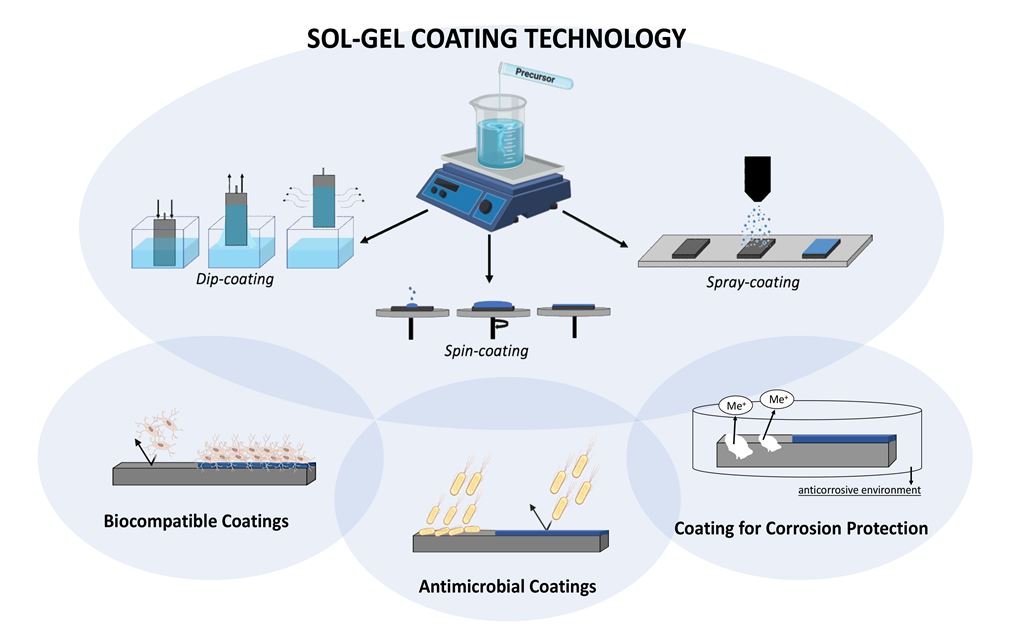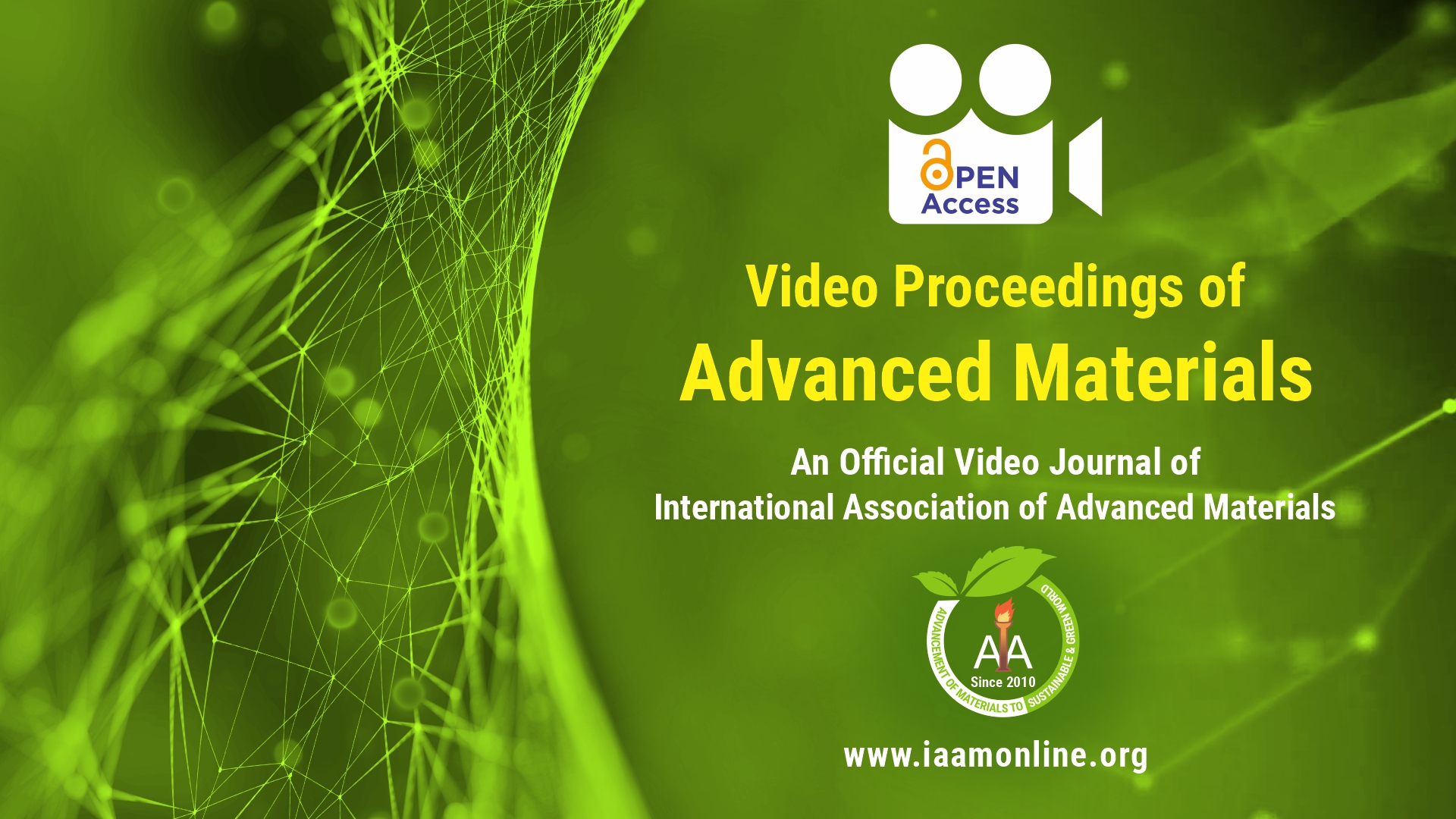Video Article Open Access
Sol-gel Coating Technology: A Tool for Long-Term Implants Lifetime Improvement
Flavia Bollino
Department of Engineering, University of Campania “Luigi Vanvitelli”, Via Roma 29, 81031 – Aversa (CE), Italy
Vid. Proc. Adv. Mater., Volume 2, Article ID 2021-02105 (2021)
DOI: 10.5185/vpoam.2021.02105
Publication Date (Web): 21 Mar 2021
Copyright © IAAM
Graphical Abstract

Abstract
The sol-gel coating technology is a versatile method to produce thin films which integrates the sol-gel process with a deposition technique. The sol-gel method is a wet-chemical technique used to produce glass and ceramic oxides at relatively low-temperature through the hydrolysis and condensation reactions of inorganic metal salts or metal-organic compounds in an alcohol-water solution. Therefore, the process leads to the transition of a system from a colloidal solution (the “sol”) into a solid “gel” [1,2]. The sol-gel method has attracted growing attention due to the several advantages, such as high chemical homogeneity and purity of the obtained products due to the use of pure raw materials in solution, flexibility, reproducibility, automation and the possibility of controlling/tailoring the chemical structure and microstructure of the obtained materials. Moreover, it is easily coupled to some deposition techniques, such as dip, spin and spray coating allowing the production of pure, homogeneous and functionalized coatings which are successfully proposed in several applications [1,2]. The present work aims to outline an overview of the sol-gel coatings use in the biomedical field and, in particular, of the employment of the sol-gel coating technology for the surface modification of metal implants as a strategy to extend their lifetime in the long-term. The aggressive bio-environment, indeed, can induce the early implant failure entailing device replacement surgery with considerable risks for patients and a significant burden for health-care systems [2]. The implant lifetime can be limited by the onset of several problems, such as wear and corrosion phenomena, low in tissue integration, adverse reactions of the immune system, biofilm formation or mechanical, chemical, tribological, surgical, manufacturing and biocompatibility problems [2]. Sol-gel coatings application on implants has been successfully proposed for hindering such processes leading to implant failure. Their use for the improvement of the bioactivity and biocompatibility of the metal devices is reported in many works [2]. Sol-gel materials indeed can induce the enhancement of the integration process by the stimulation of the hydroxyapatite nucleation due to hydroxyl groups present on the coating materials, as well as to the materials mesoporosity and, thus, their large specific surface area [3]. Moreover, the low processing temperatures make the sol-gel an ideal technique to synthesized organic-inorganic hybrids (OIHs) by embedding suitable molecules, such as polymers, drugs or biomolecules [1]. This aspect allows the design of homogeneous and crack-free coatings with specific features, suitably functionalized and with particular chemical composition. Many OIHs consisting of an antibacterial agent or an anti-inflammatory drug contained in a sol-gel matrix were proposed for preventing biofilm formation or inflammatory pathway activation respectively [2]. Inorganic and organic-inorganic coatings were successfully proposed also as protective layers for hindering wear and corrosion phenomena [2]. Therefore, the sol-gel coating technology represents a useful tool for the researchers working in the biomedical field which are employed in the challenge for the prevention of the early implant failure, still nowadays an unavoidable clinical event.
Keywords
Sol-gel method; deposition technique; metal implant.
Acknowledgement
This work was supported by the Programma VAnviteLli. pEr la RicErca -V:ALERE 2017.
References
- F. Bollino, M. Catauro, Sol-Gel Technology to Prepare Advanced Coatings. In Photoenergy and Thin Film Materials, X.-Y. Yang Ed. Wiley Scrivener Publishing LLC: Beverly, MA, 2020, 321-378.
- E. Tranquillo, F. Bollino, Coatings, 2020, 10(6), 589
- F. Bollino, E. Tranquillo, E. Armenia, Materials, 2017, 10(7), 757
Biography
Flavia Bollino is Fixed-term Assistant Professor (L. 240/2010 - art. 24, c.3-A) at The University of Campania “Luigi Vanvitelli” - Department of Engineering (Italy), where she has devoted mainly to the synthesis of biomaterials through sol-gel technique and to the chemical and microstructural characterization of them, as well as the investigation of their biological, thermal, corrosion and mechanical behaviour. She is graduated in Pharmaceutical Chemistry and Technology at the University of Naples “Federico II” and is PhD in Aerospace Science and Technology - Biomedical Section.
In the last ten years, her research activities have been focused on the following topics:
- Sol-gel synthesis of inorganic oxides (bioglass) and organic-inorganic hybrid (OIH) materials bioactive, biocompatible and with antioxidant properties
- Sol-gel synthesis of biocompatible glass and OIHs for drug delivery applications and study of the drugs release kinetics
- Surface modification of titanium implants by application of thin films via the sol-gel dip-coating technique and study of the biological and mechanical properties of the prepared coatings, as well as of their corrosion protection ability
In 2018 She achieved the National Academic Qualification (ASN 2016-2018) to become Associate Professor of Chemical Foundations of Technologies. Since November 2019, she is Editorial Board Member of the indexed international journal Coating (MDPI). Moreover, in January 2020 she joins the Scientific Advisory Board of the “33rd assembly of Advanced Materials Congress 2020”, Stockholm, Sweden, organized by the IAAM. She is a co-author in 4 book chapters (one of them was published in Photoenergy and Thin Film Materials, Yang X-Y, Ed. Wiley Scrivener Publishing LLC: Beverly, MA, 2020 after the invitation of the Prof. Ashutosh Tiwari) and in 59 publications currently indexed by Scopus (9 of which are Conference Paper), receiving 1351 citations (h-index = 25).
Video Proceedings of Advanced Materials

Upcoming Congress



